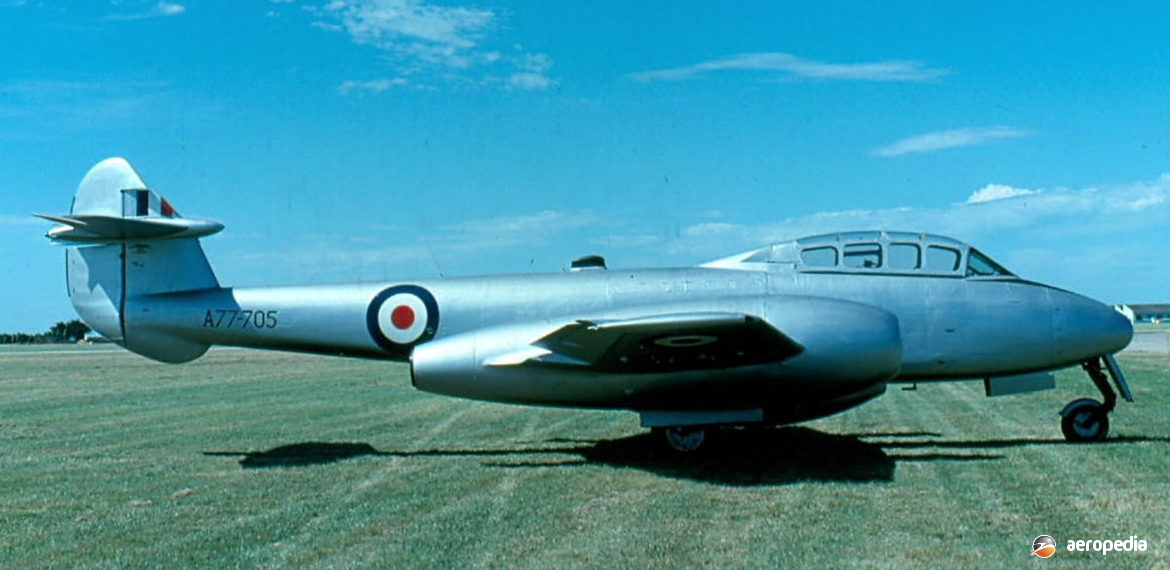Photograph:
Gloster Meteor T-7 A77-705 at Point Cook, VIC in December 1975 (David C Eyre)
Country of origin:
United Kingdom
Description:
Two-seat military trainer
Power Plant:
Two 3,600 lbst Rolls Royce Derwent 8 turbojets
Specifications:
- Wingspan: 11.33 m (37 ft 2 in)
- Length: 13.26 m (43 ft 6 in)
- Height: 3.96 m (13 ft)
- Wing area: 23.23 m² (250 sq ft)
- Max speed at sea level: 941 km/h (585 mph) or Mach 0.78
- Max speed at 9,144 m (30,000 ft): 869 km/h (540 mph)
- Cruising speed at 9,144 m (30,000 ft): 629 km/h (391 mph)
- Initial rate of climb: 2,316 m/min (7,600 ft/min)
- Time to climb to 9,144 m (30,000 ft): 6.5 mins
- Range with max external fuel: 1,609 km (1,000 miles)
- Normal range: 742 km (450 miles)
- Empty weight: 4,781 kg (10,540 lb)
- Max loaded weight: 7,983 kg (17,600 lb)
History:
The Gloster Meteor was the first British operational jet fighter, the Models F.I and F.III seeing action briefly towards the end of World War II. The type was produced in a number of variants: the F.4 and F-8 being interceptors; the T-7 two-seat trainer; the FR-9, PR-10 and NF-11 to NF-14 being night and all-weather fighters, the bulk of these being built by Armstrong Whitworth. In 1946 a Meteor F.4 flew over Melbourne, VIC at 788.5 km/h (490 mph) and this aircraft (serial EE427), which was allocated Royal Australian Air Force (RAAF) serial A77-1, was used as a trials aircraft at Laverton, VIC, and Darwin, NT.
The Meteor T-7 was a development of the F.4 powered by two Rolls Royce Derwent 5 turbojets. Unlike the F-8 single-seat fighter, the cockpits were not pressurised, but some T-7s, as they were designated, were fitted with an F-8 type tailplane as opposed to that fitted to the F.4. More than 500 examples of the T-7 were completed.
Ninety-three Meteor F-8s and six Meteor T-7s were operated by the RAAF in Australia and in the Korean campaign, and these initially had scattered serials ranging from A77-2, a T-7, to A77-982, an F-8. Following the cessation of hostilities, 41 Meteor F-8s and three T-7s returned to Australia on board ‘HMAS Vengeance’ and remained in service until they were replaced by the CAC built CA-27 Sabre. For a period they were flown with the Citizens Air Force Squadrons, but were finally retired in 1963.
Altogether the RAAF operated nine Meteor T-7s: serials A77-2 (ex-VW410); A77-4 (ex-WN321); A77–701 (ex-A77-729); A77-702 (ex- A77-305, WA732); A77-703 (ex-A77-380, WG974); A77-704 (ex-A77-577, WG977); A77-705 (ex- WA680); A77-706 (ex-WF843); and A77-707 (ex-WH118). Of these, A77-701 is known to have operated with a modified PR-9 nose; A77-703 crashed whilst with No 77 Squadron on 20 June 1955; and A77-704 crashed on 6 September 1952 in a thunderstorm. Two others were used by No 75 Squadron in Malta: WH220 crashing on take-off on 18 January 1954 at Takali, and WH238 returneingto the Royal Air Force (RAF).
The Meteor T-7 was used by No 14 Squadron Royal New Zealand Air Force (RNZAF) in the Middle East on loan from the RAF when that unit operated in Cyprus as part of the British Commonwealth presence in the 1950s. These were aircraft borrowed for training purposes from the RAF, WH206 from October 1952 to November 1953 and WL400 from October 1952 to March 1955. They both retained their RAF camouflage and markings.
A number of Meteors were used for trials at Woomera, SA and these included several T-7s and ex-RAF NF-11s and TT-20s. After retirement, and following their disposal, a number of T-7s have survived and these have included: A77-702 and A77-705 at the RAAF Museum at Point Cook, VIC; and A77-707 at the National Aviation Museum at Moorabbin, VIC.

